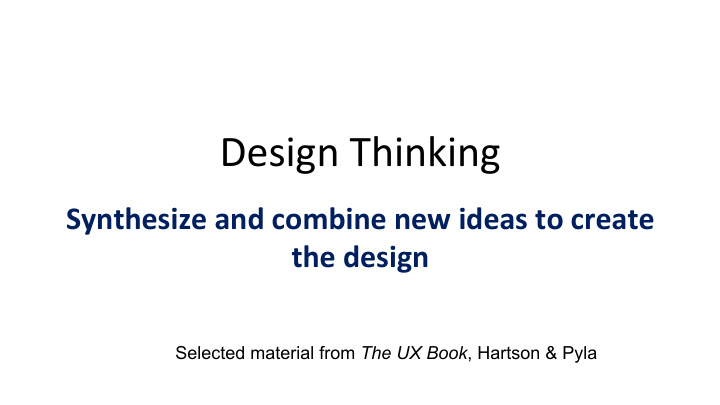



Design'Thinking' Synthesize*and*combine*new*ideas*to*create* the*design ' SWEN/444' Selected material from The UX Book , Hartson & Pyla
Use'of'term' � design � ' • We mainly use � design � narrowly to refer to creative human activity • How new ideas are synthesized and put together – Usually meaning will be obvious from context – And, of course, it is about interaction design 4
Three design paradigms (patterns of thinking) • Engineering – focus on user productivity, avoiding errors, achieved through evaluation and iteration • Human Information Processing (HIP) – cognitive science based, focus on study of how information is sensed, accessed, and transformed in human mind • Design-Thinking – consider emotional and phenomenological, social and cultural aspects for the UX, focus more on getting right design than on refining design later
Example:'Car'Design' Engineering view HIP view Design Thinking view cool factor, joy of driving, life Seat height, fit of the curve Meets limits of human signal style considerations, pride of on the seat to fit lower back detection (tactile via steering ownership, thrill of speed shape, safety restraints, wheel, audio cue, blinking airbags visual cue e.g. low tire pressure)
Design'Thinking' • Creative and innovative UX design • Tools: concept first • Understanding emotions • Combination of art, craft, science, • Persona invention • Ideation • Followed by functional and • Sketching interactive design ' Long'term' emo4onal*impact* • Aesthe4cs* • • Social and value oriented interaction • How technology takes on � presence � in user � s life • May be market driven (think Apple)
Plutchik's' 'Wheel'of'EmoAons'
Personas'–'a'Pretend'User' • A specific (but imaginary) person in a specific work role; • Represent a class of users • Composite user archetypes based on behavioral data gathered from many actual users • Make design thinking more concrete • User roles are too broad – can’t satisfy everyone • Focus and satisfy one “person” • Minimize designer bias to design for their own needs; engage designer empathy • Select a small number of personas from the user class • Pick one as primary and design for that one • Adjust as necessary to accommodate the others
ConstrucAng'Personas' Establish'a'persona'hypothesis' • Segment'use'across'a'set'of'observed'behavioral'variables'(also'called' • axes'or'ranges)' E.g.,'computer'literacy,'annual'income' • IdenAfy'significant'behavior'paGerns' • Clusters'of'users'with'shared'behavior'across'mulAple'behavioral'variables'(6/8)' • Valid'paGerns'demonstrate'logical'or'causaAve'relaAonships'between'clustered' • behaviors' Combine'one'of'more'paGerns'into'a'persona'role' • Synthesize'persona'characterisAcs'and'relevant'goals' • Review'for'completeness'and'disAncAveness' •
Do'not'design'for'the'“average”'user.'
A'cast'of'personas'represent'different'clusters'of'behaviors.''
Synthesize'CharacterisAcs' Give'each'major'paGern'a'brief'descripAon,'such'as'"the'bargain/hunter"' • or'"the'impulse/buyer"'' Synthesize'details'from'the'data' • Describe'use'environment,'typical'workday'(or'other'relevant'Ame'period),'current' • soluAons'and'frustraAons,'relevant'relaAonships,'etc.' SAck'to'observed'behaviors' • Avoid'too'much'ficAonal,'idiosyncraAc'biography' • A'persona'is'a'design'tool,'not'a'character'sketch'for'a'novel' • Carefully'select'a'first'[and'last]'name'for'the'persona' • EvocaAve'of'the'type'of'person'the'persona'is' • Add'some'demographic'informaAon:'age,'geographic'locaAon,'relaAve' • income'(if'appropriate),'job'Atle'
Example'Persona'
IdeaAon' • Collaborative group process for forming conceptual design ideas; i.e.,'“applied'design'thinking” • Idea creation • Idea critiquing – review and judgment • Brainstorming' • Team activity • Stream-of-consciousness • Generate as many ideas as possible • Don’t be critical of or constrain creativity • Brainstorming'sessions'generate'a'lot'of'material'that'must' be'filtered'and'organized' • Categorize, sort, vote
IdeaAon:'Set'up'Work'Spaces'
Dissent'' An'alternaAve'to'brainstorming' • ParAcipants'encouraged'to'criAcize'ideas' • CriAcism'surfaces'problems'that'forces'new'thinking'to' • respond' Produces'more'producAve'and'innovaAve'ideas' • BLACK BOX THINKING: Why Most People Never Learn From Their Mistakes—But Some Do by Matthew Syed
Example:'IdeaAon'for'the'Ticket'System' Thought'quesAons'to'get'started:' • • What'does'"an'event"'mean?'How'do'people'treat'events'in'real'life?' • An'event'is'more'than'something'that'happens'and'maybe'you'aGend' • An'event'can'have'emoAonal'meanings,'can'be'thought'provoking,'can'have' meaning'that'causes'you'to'go'out'and'do'something' Things'people'might'want'to'do'with'Ackets:' • • People'might'want'to'email'Ackets'to'friends' Possible'features'and'breadth'of'coverage:' • • Homecoming'events' • Parents'weekend'events' • VisiAng'speakers'on'current'topics' • Visitor's'guide'to'what's'happening'in'town'and'the'university' • Christmas'tour'of'Middleburg'
Sketching' • Rapid creation of freehand drawings • Expressing preliminary design ideas • Focusing on concepts rather than details • Reinforces design thinking, augments communication • Explore and expand design ideas • Sketches are not prototypes • They are abstract, incomplete, not artistic, disposable, fast, annotated '
Example:'Smart'Outdoor'Lights' The'main'purpose'of'these'lights'is'to'save'electricity.'It'runs'on'solar' • power'and'provides'intelligent'lighAng.'The'way'it'works'is'by'providing' light'and'hence'consuming'power'only'when'required.'' The'new'smart'outdoor'light'saves'power'by'making'use'of'sensors'which' • detect'acAvity'around'them.'They'can'also'communicate'with'one'another' over'the'network'to'smartly'and'efficiently'light'up'when'required.'
Example:'Smart'Outdoor'Lights'
Example:'Smart'Outdoor'Lights'
Example:'Smart'Outdoor'Lights'
Example:'Smart'Outdoor'Lights'
AcAvity:' 1/'Construct'a'detailed'descripAon'of'the'persona'for'your'main'work'roles' 2/'Create'a'new'design'vision.'Here'you'are'totally'focused'on'the'user'experience.'' Engage'in'ideaAon,'to'rapidly'create'and'compare'a'large'number'of'design' • alternaAves.''' Everyone'in'turn,'start'throwing'out'ideas'for'discussion.'' • Make'sketches'simultaneously'and'hang'them'on'the'wall.'Feel'free'to'use'the' • whiteboard'for'brainstorming'and'drawing.'' Remember to keep separate idea creation and critiquing. In the idea creation phase, keep the rich ideas flowing. No idea is too far out. When that well starts running dry, switch to critiquing and evaluate the ideas, winnowing out the most promising ones.
Recommend
More recommend